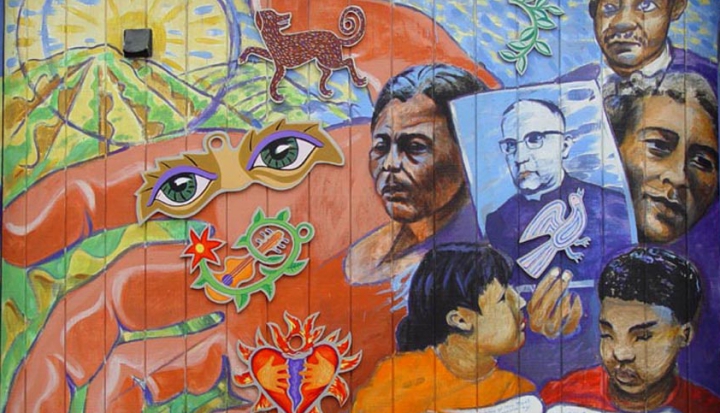A group of Christians gathers at the Nevada test site to witness against the folly of nuclear weapons. In their prayers, before some of them are arrested, they honor the memory of Franz Jagerstätter, a young Austrian killed by the Nazis because, as a follower of Christ, he would not serve in their war machine.
During a preparation session for Baptism, a parish team explains the Litany of the Saints that will be said at the ceremony: “We are remembering the men and women of the parish and of our families who have gone before us, who stand with us as we baptize these children.” People may add to the litany the names of holy persons special to their families.
Circles of women supporting each other in the struggle for their dignity in the church and society include in their prayers a remembrance of women whose witness encourages them: Mary Magdalene, Joanna, Susanna, Phoebe, Catherine of Siena, Mary Ward, Marjorie Tuite.
In San Salvador, steady streams of poor people keep vigil at the tomb of Archbishop Oscar Romero; they find strength and consolation in the living memory of his love for them and are encouraged to continue the struggle for justice.
What is going on in these simple moments—which in their endless repetitions around the world reveal something of the essence of Catholic Christianity? In these moments we see the living practice of the communion of saints. Belief in the communion of saints is confessed in the Apostles’ Creed in connection with other beliefs that support it: “I believe in the Holy Spirit, the holy Catholic Church, the communion of saints, the forgiveness of sins, the resurrection of the body, and life everlasting. Amen.”
What does this aspect of our faith mean? How does understanding and practicing it lead to a richer Christian life today? A superb clue is found when we trace how this belief begun.
One people of God
The early Christians thought of themselves as a community of disciples of Jesus Christ, filled with his Spirit, gathered around his table, following his Way. Because of this, they were all called saints, a word taken from the root word for holy. They were all touched by the holiness of God.
Saint Paul begins almost all of his letters this way: “To the church of God which is at Corinth, with all the saints who are in the whole of Achaia” (2 Cor. 1:1); “To all the saints in Christ Jesus who are at Philippi” (Phil. 1:1); and “To all God’s beloved in Rome who are called to be saints” (Rom. 1:7). The communion of saints was a reality then. It was the vital community of people who, despite their troubles and their sinfulness, were redeemed by Christ and sealed with the one Spirit. They were the branches with the vine, one people of God.
A new question arose when members of the community began to die, some of them at the hands of persecutors. The logic of faith led the early Christians to see that even death was not strong enough to break their bond with Christ. Paul is eloquent on this: “Who shall separate us from the love of Christ? … I am sure that neither death nor life, nor angels, nor principalities, nor things present nor things to come, nor powers, nor height nor depth, nor anything else in all creation, will be able to separate us from the love of God in Christ Jesus, our Lord” (Rom. 8:35-39).
Since those who died were still joined with Christ, they still belong to the community of saints. The community began to expand to include both those living on earth and, as the Eucharistic Prayer tells us, “those who have died and have gone before us marked with the sign of faith.”
This development received a major boost when persecution against the church broke out in earnest. From the second to the fourth centuries, many martyrs gave up their lives rather than renounce their faith. Condemned, bloodied, and executed, they were perceived by other Christians as icons of Jesus Christ, entering into his dying in a graphic way and so, also, into his rising to new life. Their example encouraged the community to deep living of discipleship.
Christians loved these martyrs, cherished their memory, and found ways to express respect and esteem. When possible, the bodies of martyrs were retrieved and carefully buried. Their graves became places of prayer in pilgrimage. On the yearly anniversaries of their deaths, nightlong vigils would be held at their graves, culminating in a Eucharist at dawn. In time, the stories of particular martyrs spread beyond their own locales, and they were venerated by the church in other places.
It seems that some critics accused Christians of abandoning Christ and replacing him in their affections with the martyrs. But the true meaning of the martyrs in the life of the community was explained by an anonymous member of the church at Smyrna after their bishop, Polycarp, was burned to death by Roman authorities in 167 A.D.:
We never forsake the Christ who suffered to save those who are saved in the whole world, nor worship anyone else. For we worship him since he is the Son of God. But the martyrs we love as disciples and imitators of the Lord, and worthily because of their matchless affections for their own king and teacher. May we too become their comrades and fellow disciples.
Note the relationship between those still struggling on earth and those who had been sealed with the victory of Christ. They are bonded together, enfolded into a mutual love, with one group inspiring the other. This lively sense of the communion between saints on earth and in heaven is beautifully expressed in one of Augustine’s sermons on the feast of the young women martyrs Perpetua and Felicity:
Let it not seem a small thing to us that we are members of the same body as these. … We marvel at them, they have compassion on us. We rejoice for them, they pray for us. … Yet do we all serve one lord, follow one master, attend one king? We are joined to one head, journey to one Jerusalem, follow after one love, embrace one unity.
Augustine preaches that all the followers of Jesus Christ form a genuine, grace-filled community. We are all at different stages of life’s journey and respond to each other accordingly, but the relations are mutual and flow back and forth. The more we connect with one another, the deeper becomes our belonging to Christ.
This, then, is the historical context for the beginnings of the belief in the communion of saints: a tense and dangerous time for the budding church; a time when the martyrs were loved for their witness under extreme pressure; a time when the church began to honor their memories liturgically in annual feast days. In later centuries when martyrdom was no longer an ever-present possibility, other holy women and men, whose lives gave bright patterns of holiness to the church, continued to be honored by name after their deaths. Unlike New Testament usage, the word saint began to be used mostly of those good persons who were now with God on the other side of death.
Saints known and unknown
The community of saints in heaven is an enormously inclusive group, made up of persons both known and unknown. In addition to the martyrs who are known by name, the Christian roll call includes persons whose lives are known from the biblical text, such as Mary the mother of Jesus, Peter and Paul, and Mary Magdalene. Other particular persons whose lives have a special significance for the community because of their outstanding love, learning, pastoral ministry, or spirituality are also recognized as special and remembered by name.
In the church’s first 1,000 years, this acknowledgement occurred in a rather informal way by the people and bishops of each local church. Saints were identified thanks to the spiritual intuition of the communities whose lives they had touched. Much the same process is now at work in devotions to the poignantly new generation of martyrs, such as Archbishop Romero or the four North American church women killed in El Salvador. Their influence is already widespread among the faithful who instinctively recognize their holiness.
From the 10th to the 13th century there was a gradual movement toward papal involvement in the naming of saints; as a result, a long and detailed process of canonization took the place of popular acclaim.
To be canonized now means to be inscribed on the canon or list of officially recognized holy ones. One problem with this process is the amount of time, money, and influence it requires. As a result, more men than women, more clergy and members of religious orders than married laity, more Europeans than other nationals, and more wealthy than poor people are currently inscribed on the official list of canonized saints and honored during the liturgical year (roughly three fourths to one fourth in each category).
The community of holy ones, however, is much broader than the list of official saints. Even if canonization were to disappear, the communion of saints would still flourish—for this includes all holy men and women who have died and are alive in God—in a vivid communion of life with the pilgrim church still on its journey through history. Most of these people are unknown to us by name. They are the ones who lived quietly in the land, the poor and little ones who were great only in God’s eyes, who go unmentioned on the honor rolls of the church or world history. They form the great cloud of witnesses whose faithful love in ordinary lives throughout the ages has passed the living tradition of the gospel down to us. Others, happily, are known to us, being family or community members or friends whose love and insight shaped us as loving, believing human beings.
The feast of All Saints honors this ever-widening circle. At first it was celebrated on the Sunday after Pentecost, a date it still holds in the Byzantine rite. If Easter marks Jesus’ victory over death and Pentecost marks Christ’s sharing of new life with the pilgrim church on earth through the outpouring of the Spirit, then the next Sunday’s feast of All Saints marks the fulfillment of the mystery of salvation as the church begins to be harvested into heaven. Despite its different timing on the calendar of the western churches, the feast of All Saints still honors the lives of all good people who have died and are now with God and in living communion with the church on earth. Some day it will be the feast of those who celebrate it now—we hope. Future generations will celebrate the fruitfulness of God’s grace in us as the great earth rolls around the sun.
Let us gather these reflections from history and liturgy into a holistic religious view and ask, What is the meaning of the communion of saints for the life of faith today?
The church is a community of shared life in Jesus, wherein everyone is called to holiness. In this community, as in all human life, no one is a solitary player, but everyone depends on everyone else and is affected for better or worse by what others do or omit to do. When anyone responds to the gift of grace, the shape of his or her life becomes an influence that strengthens faith for others.
This religious solidarity in the Spirit is so strong that even death cannot break it. As Paul wrote, “Whether we live or whether we die, we are the Lord’s” (Rom. 14:8). Hope courageously affirms that God saves those who are faithful—forgiving their sins, blessing their love, not letting one of them get lost. In and beyond death they abide in a living community with God and thereby with all others in a completely new way. If the dead in Christ are with God through the power of the Spirit and so, too, are the living, then they are with each other. This is the communion of saints.
We should be clear about the fact that we have no adequate image or concept of what life in God is like after death. Death is impenetrable. As Paul again wrote, “Eye has not seen nor ear heard nor the human heart conceived what things God has prepared” (1 Cor. 2:9). Care must be taken lest we naively imagine the saints in heaven engaging in transactions of give and take along the line of earthly models. As is the case with Jesus himself, the saints have entered into the inner sanctum behind the veil (Heb. 6:19), and their situation is more unlike than like ordinary human existence.
Nevertheless, the saints are part of God’s people, and in fact, the beginning of the final community of the redeemed. In their lifetimes their own life stories were woven into the story of Jesus as they responded to the challenge of new situations. Now they are companions to those still on the way, sisters and brothers in faith. The solidarity of the church thus extends not only across geographic time lines to include all living believers on different continents but also across time itself to include diverse disciples of all ages.
Victors and risk takers
In this community, saints function like sacraments. They’re signs of the victory of God’s grace, which can transform human weakness and sinfulness. They are examples of the different ways discipleship can be lived, some even having taken successful risks to forge new paths of holiness in new cultural settings. Most of all, they are signs of hope, living pledges of the divine promise of the future, showing us that the struggle for love and justice is worth it. Their prayers for the church strengthen us all in faith.
In response, the living church honors the saints by loving these friends of Christ and cherishing their memory—as Vatican II puts it. This is done when we tell their stories; when we thank God for them; when we take a clue from their example for our own pattern of life; when in the midst of suffering and oppression, we allow the act of justice; when we call upon them as partners in the struggle. Being aware of the communion of saints in the various ways, as the late theologian Karl Rahner so beautifully put it, enables us to “take refuge in the community of the redeemed.”
And what is the spiritual benefit of this remembrance? Most fundamentally it energizes hope and community. In the face of the ever-present temptation to despondency, active belief in the communion of saints is a movement of hope in God, who raises the dead to life and promises a future to all the dead, to our loved ones, even to us. It is also a corrective against excessive individualism and religious narrowness. Rather, surrounded by our sisters and brothers, we as church express a more holistic vision of the reign of God. In their company we find our faith strengthened and our will empowered in the conflict against the powers of evil, whether ordinary or extraordinary. Vatican II summed it up this way:
Just as Christian communion among the wayfarers brings us closer to Christ, so our companionship with the saints joins us to Christ, from whom as from their fountain and head issue every grace and the life of God’s people itself.
This article appeared in the November 1994 issue of U.S. Catholic (Vol. 59, No. 11).
Image: Flickr photo cc by Franco Folini














Add comment